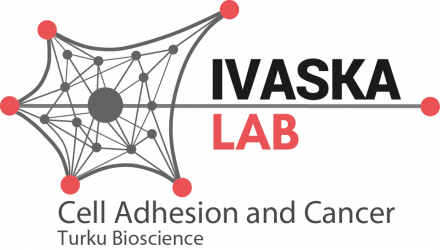-
SHARPIN regulates collagen architecture and ductal outgrowth in the developing mouse mammary gland by Emilia Peuhu et al.
SHARPIN is a widely expressed multifunctional protein implicated in cancer, inflammation, linear ubiquitination and integrin activity inhibition; however, its contribution to epithelial homeostasis remains poorly…
-
L-type calcium channels regulate filopodia stability and cancer cell invasion downstream of integrin signalling by Guillaume Jacquemet et al.
Mounting in vitro, in vivo and clinical evidence suggest an important role for filopodia in driving cancer cell invasion. Using a high-throughput microscopic-based drug screen,…
-
Fetal liver endothelium regulates the seeding of tissue-resident macrophages by Pia Rantakari et al.
Macrophages are required for normal embryogenesis, tissue homeostasis and immunity against microorganisms and tumours. Adult tissue-resident macrophages largely originate from long-lived, self-renewing embryonic precursors and…
-
The complexity of integrins in cancer and new scopes for therapeutic targeting by Hellyeh Hamidi et al.
Cancer is a complex disease and progresses within a dynamically evolving extracellular matrix that controls virtually every aspect of the tumour and tumour-associated cells. Interactions…
-
Normal stroma suppresses cancer cell proliferation via mechanosensitive regulation of JMJD1a-mediated transcription by Riina Kaukonen et al.
Tissue homeostasis is dependent on the controlled localization of specific cell types and the correct composition of the extracellular stroma. While the role of the…
-
Vimentin coordinates fibroblast proliferation and keratinocyte differentiation in wound healing via TGF-β-Slug signaling by Fang Cheng et al.
Vimentin has been shown to be involved in wound healing, but its functional contribution to this process is poorly understood. Here we describe a previously…
-
Corrigendum: Beta 1-integrin-c-Met cooperation reveals an inside-in survival signalling on autophagy-related endomembranes by Rachel Barrow-McGee et al.
No abstract
-
Beta 1-integrin-c-Met cooperation reveals an inside-in survival signalling on autophagy-related endomembranes by Rachel Barrow-McGee et al.
Receptor tyrosine kinases (RTKs) and integrins cooperate to stimulate cell migration and tumour metastasis. Here we report that an integrin influences signalling of an RTK,…
-
Endosomes: Emerging Platforms for Integrin-Mediated FAK Signalling by Jonna Alanko et al.
Integrins are vital cell adhesion receptors with the ability to transmit extracellular matrix (ECM) cues to intracellular signalling pathways. ECM-integrin signalling regulates various cellular functions…
-
Regulation of Cell Migration and β1 Integrin Trafficking by the Endosomal Adaptor GGA3 by Colin D H Ratcliffe et al.
The integrin family of cell adhesion receptors link extracellular matrices to intracellular signaling pathways and the actin cytoskeleton; and regulate cell migration, proliferation and survival…
-
Integrin “endoadhesome” signaling suppresses anoikis by Jonna Alanko et al.
No abstract
-
Selective integrin endocytosis is driven by interactions between the integrin α-chain and AP2 by Nicola De Franceschi et al.
Integrins are heterodimeric cell-surface adhesion molecules comprising one of 18 possible α-chains and one of eight possible β-chains. They control a range of cell functions…
-
Mutually Exclusive Roles of SHARPIN in Integrin Inactivation and NF-κB Signaling by Nicola De Franceschi et al.
SHANK-associated RH domain interactor (SHARPIN) inhibits integrins through interaction with the integrin α-subunit. In addition, SHARPIN enhances nuclear factor-kappaB (NF-κB) activity as a component of…
-
Integrin endosomal signalling suppresses anoikis by Jonna Alanko et al.
Integrin-containing focal adhesions transmit extracellular signals across the plasma membrane to modulate cell adhesion, signalling and survival. Although integrins are known to undergo continuous endo/exocytic…
-
Formin-like 2 Promotes β1-Integrin Trafficking and Invasive Motility Downstream of PKCα by Ying Wang et al.
Regulated turnover of integrin receptors is essential for cell adhesion and migration. Pathways selectively regulating β1-integrin recycling are implicated in cancer invasion and metastasis, yet…
-
Filopodia in cell adhesion, 3D migration and cancer cell invasion by Guillaume Jacquemet et al.
This review discusses recent advances in our understanding of the role filopodia and filopodia-like structures in cell adhesion and three dimensional (3D) cell migration both…
-
Integrin bondage: filamin takes control by Nicola De Franceschi et al.
No abstract
-
Vimentin-ERK Signaling Uncouples Slug Gene Regulatory Function by Reetta Virtakoivu et al.
Epithelial-mesenchymal transition (EMT) in cells is a developmental process adopted during tumorigenesis that promotes metastatic capacity. In this study, we advance understanding of EMT control…
-
Blocking integrin inactivation as an anti-angiogenic therapy by Pipsa Saharinen et al.
During angiogenesis, endothelial cell migration is coordinated by integrin-mediated contact with the extra-cellular matrix (ECM), coupled with receptor tyrosine kinase signalling to regulate dynamic cytoskeletal…
-
Johanna Ivaska: Finding opposing forces in integrins by Johanna Ivaska et al.
Ivaska has taken the road less traveled to show how integrin inactivation regulates cell migration and invasion.
Our publications
For all publications visit Google Scholar

